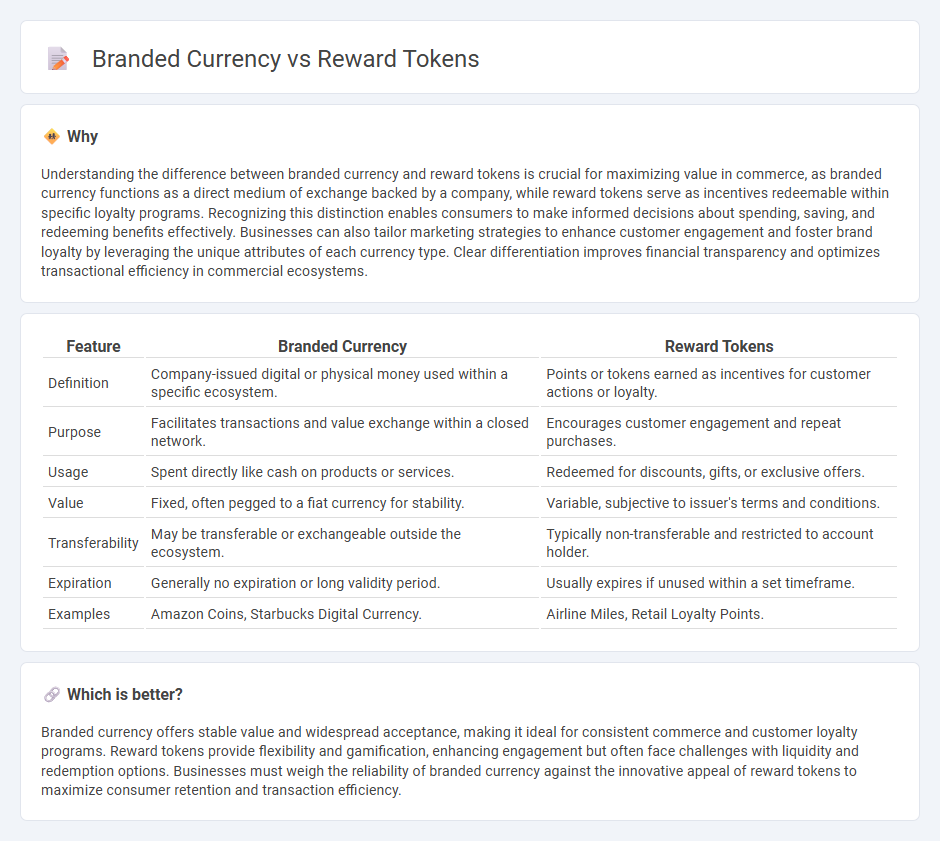
Branded currency represents a proprietary form of money issued by a company, designed to enhance customer loyalty and streamline transactions within its ecosystem. Reward tokens function as digital or physical incentives earned through purchases, which can be redeemed for discounts, products, or services, fostering repeat business and customer engagement. Explore how these financial tools shape modern commerce strategies and drive consumer behavior.
Why it is important
Understanding the difference between branded currency and reward tokens is crucial for maximizing value in commerce, as branded currency functions as a direct medium of exchange backed by a company, while reward tokens serve as incentives redeemable within specific loyalty programs. Recognizing this distinction enables consumers to make informed decisions about spending, saving, and redeeming benefits effectively. Businesses can also tailor marketing strategies to enhance customer engagement and foster brand loyalty by leveraging the unique attributes of each currency type. Clear differentiation improves financial transparency and optimizes transactional efficiency in commercial ecosystems.
Comparison Table
| Feature | Branded Currency | Reward Tokens |
|---|---|---|
| Definition | Company-issued digital or physical money used within a specific ecosystem. | Points or tokens earned as incentives for customer actions or loyalty. |
| Purpose | Facilitates transactions and value exchange within a closed network. | Encourages customer engagement and repeat purchases. |
| Usage | Spent directly like cash on products or services. | Redeemed for discounts, gifts, or exclusive offers. |
| Value | Fixed, often pegged to a fiat currency for stability. | Variable, subjective to issuer's terms and conditions. |
| Transferability | May be transferable or exchangeable outside the ecosystem. | Typically non-transferable and restricted to account holder. |
| Expiration | Generally no expiration or long validity period. | Usually expires if unused within a set timeframe. |
| Examples | Amazon Coins, Starbucks Digital Currency. | Airline Miles, Retail Loyalty Points. |
Which is better?
Branded currency offers stable value and widespread acceptance, making it ideal for consistent commerce and customer loyalty programs. Reward tokens provide flexibility and gamification, enhancing engagement but often face challenges with liquidity and redemption options. Businesses must weigh the reliability of branded currency against the innovative appeal of reward tokens to maximize consumer retention and transaction efficiency.
Connection
Branded currency and reward tokens both serve as digital incentives within commerce ecosystems, enhancing customer engagement and loyalty. Branded currency functions as a company-specific digital medium of exchange, while reward tokens represent earned benefits redeemable for discounts or exclusive offers. Their integration facilitates seamless transactions, strengthens brand affinity, and drives repeat purchases by providing customers with tangible value.
Key Terms
Loyalty Programs
Reward tokens serve as digital assets in loyalty programs, offering users points redeemable for goods or services, while branded currency functions as a proprietary medium of exchange within a specific ecosystem. Both mechanisms enhance customer retention by incentivizing repeat purchases and fostering brand allegiance through tailored benefits and exclusive offers. Explore the differences and advantages of each system to optimize your loyalty program strategy.
Redemption Value
Reward tokens often provide higher redemption value by allowing users to exchange points for a wide range of products, services, or exclusive experiences, enhancing customer loyalty and satisfaction. Branded currencies typically hold fixed redemption values within specific ecosystems, offering stability but less flexibility compared to reward tokens. Explore detailed comparisons to optimize your loyalty program's redemption strategy and maximize customer engagement.
Consumer Engagement
Reward tokens enhance consumer engagement by offering flexibility and perceived value across multiple platforms, incentivizing repeat purchases and brand loyalty. Branded currency strengthens brand identity through exclusivity and controlled redemption options, fostering deeper emotional connections with customers. Explore how combining both strategies can maximize consumer engagement and drive sustainable growth.
Source and External Links
Reward tokens - TPT - Reward tokens are educational resources used by teachers for positive behavior management and skill-building, including token boards with visual goals and prizes for students PreK-2nd grade.
Reward Token - Etsy - Handmade and custom reward tokens available for classroom motivation and rewards systems, including themed jars, chore tokens, and personalized options for kids.
TokensFor School Reward Token Range - Offers a wide range of reward tokens designed to enhance classroom motivation and behaviour, available in various styles and sizes, with free delivery to the UK mainland.
 dowidth.com
dowidth.com